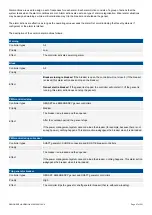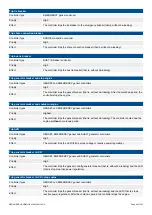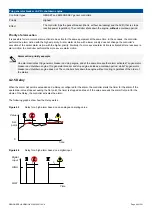
INFO
For most alarms the
Trigger level
is set and cannot be changed. Custom I/O alarms can be configured for
High
or
Low
setting of the
Trigger level
.
4.2.9 Auto acknowledge
When
Auto acknowledge
is selected, the alarm is immediately marked as acknowledged in the alarm display when the alarm is
activated.
Alarms that have a
Latch
configured, even if automatically acknowledged, still require unlatching by the operator.
4.2.10 Latch
You can configure a
Latch
on any alarm. When an alarm with a
Latch
is activated, the alarm
Action
remains in force until the alarm is
acknowledged and then reset (unlatched). Alarm latching provides an extra layer of safety.
For example, you can create a low oil pressure alarm with a latch and a
Trip generator breaker and shutdown engine
alarm action.
Then, if there is low oil pressure, the controller trips the breaker and stops the engine. The engine remains stopped and will not be
able to start until the alarm is reset.
CAUTION
Enabling a
Latch
on an alarm is not enough for safety protection. To be effective, the alarm must also be
Enabled
, and the
alarm
Action
must be effective against the unsafe situation. For example, a
Latch
on an alarm with the action
Warning
offers little extra protection.
4.2.11 Suppress action parameter
All controllers
For all controller types, an alarm action is suppressed when
Suppress action
is
Enabled
for the alarm, and the function
Alarm
system > Additional functions > Suppress alarm action
is activated by a digital input, PICUS, Modbus, and/or CustomLogic.
If the alarm action is suppressed, when the alarm is activated, the alarm is shown in the alarm handling system, but the alarm action
is only
Warning
.
EMERGENCY genset controller
If there is a blackout, then the EMERGENCY genset controller must ensure that power is restored to the emergency busbar as soon
as possible.
For the EMERGENCY genset controller, when
Suppress action
is selected for an alarm, the alarm action is suppressed during the
blackout recovery. The alarm is shown in the alarm handling system, but the alarm action is only
Warning
.
More information
See
Power management, Blackout
for more information about blackout recovery.
4.2.12 Alarm test
The alarm test activates the alarm and its alarm action. You can use the alarm test parameter to test individual alarms, for example,
during commissioning.
CAUTION
Alarm tests activate alarm actions, some of which can force the system to switchboard control, trip breakers, create a
blackout, and shut down engines. Use extreme care when performing alarm tests during normal operation.
Alarm tests of individual alarms can be stopped one at a time using the parameter, or at the same time using the
Stop test
button on
the
Alarms
page in PICUS.
DESIGNER'S HANDBOOK 4189340911K UK
Page 101 of 521
















































